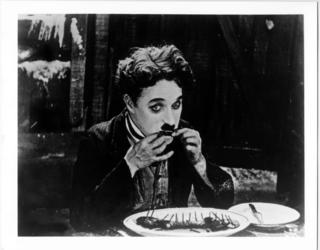1. Through the in class discussion and power points, I learned that Charles Spencer Chaplin was ranked in the top 25 best Auters of all time. To be an auter meant that the director also played an integral part in the film. Chaplin, in particular, was director, producer, and actor, to name a few roles. This was seen in the viewing of The Gold Rush, a silent film released in 1925 by Chaplin. He created a character that represented the underdog in society who yearned for acceptance, love and respect. This character was called the tramp and he was a very generous and kind person. The tramp was one of the main characters in The Gold Rush and was played by Chaplin himself. The tramp was the main source of comedy in this film. In class, we learned that there are different forms of film structure. In this particular film by Chaplin, we are introduced to a circular structure. As discussed, and then seen, the tramp sets out on a journey to Alaska during the gold rush. In the end of the film we see this same character returning home.
This article is titled “Filming
the Gold Rush” and was written by David Robinson. I located this article via
charliechaplin.com under the biography section. It opens up with Chaplin’s
inspiration for the creation of the film. He viewed photos of the gold rush
occurring in Alaska and read a book that pertained to the Donner Party Disaster
of 1846, which was an incident where “immigrants were reduced to eating their
own moccasins and the corpses of their dead comrades.” The author of this
article points out that Chaplin believed that “tragedy and ridicule are never
far apart.” Chaplin created the Gold Rush with these ideas in mind. Production
of this film was dragged on due to personal struggles in Chaplin’s life and it
is to be noted that this was “the most elaborate undertaking of his career.”
Chaplin filmed on site in the Sierra Nevada where the book he derived
inspiration from took place. He had six hundred extras to film the scene of
masses of people taking the journey up the snow-covered mountain. The rest of
the film was shot on a set in the Hollywood studio. To make comedy out of
tragedy, Chaplin created a scene where he made a meal out of his shoe, again
revisiting his inspiration. A crowd-pleasing scene in The Gold Rush is when
Chaplin takes two forks and two dinner rolls and dances with them on the table.
This scene was played as an encore in some theaters. After The Gold Rush was
produced, Chaplin revived the film with sound. This was done with the addition
of an orchestra or himself speaking the inter-titles. The author of this
article stated at the end that this film “appears as one of Chaplin’s most
perfectly accomplished films…and the one by which he would most wish to be
remembered.”
3.
After reading the aforementioned article, I have
a better understanding of where the scenes were derived from. Knowing now where
he gained his inspiration from generates a greater appreciation for the comedic
scene in which Chaplin cooks his shoe for dinner. There is a larger, societal
meaning behind the scene besides the surface humor. It was interesting to learn
how much went into creating the film, as well. When the film was produced,
there was not access to special effects in the way we use and see them today.
While filmmakers today go onsite to film specific portions of their film, they
do not have to use as many extras as Chaplin did to recreate the scene of
hundreds of people climbing a snow covered mountain.
4.
Chaplin creatively produced a film in which
underlying societal issues are portrayed in a comedic style. I found that,
given the lack of special effects and editing equipment we have today, his film
is fairly seamless. The use of the tramp to recreate historical scenes was very
fitting as well. Learning that he gained his inspiration from a book about
immigrants being subject to eating their shoes, and even their dead comrades, I
feel this is a good representation. In class, it was discussed the definition of
an auter. I can now agree that Chaplin should be ranked as one of the greatest.
It is interesting to learn, and then see, how involved early filmmakers could
be in the production of their films. Chaplin was a hands-on artist and I can
see that he took pride in his work.
